A Cremation in Bali
The three giant black bulls had been sitting in state outside Ubud Palace for a day or so, golden necklaces adorning their necks, their dangling balls covered in gilded hair and their pink felt penises complete with a string so celebrants could wiggle them at will.
The occasion? Why, a cremation.
In Bali, what else?
And, mercifully, unlike the bulls we saw sacrificed at a funeral in Tana Toraja, they were thoroughly fake.
These three gilded sarcophagi were awaiting the auspicious moment when the three royal siblings who died within a month of each other could be consigned to flames. A date determined by the Balinese calendar, where weeks lasting from 1 to 10 days run concurrently with each other, and the stars count too.
They moved to the street early in the morning, lashed onto bamboo carrying frames, maybe 30 foot square. Behind them, two tall, sparkling funeral towers, adorned in gorgeous papers, shades of greens and reds and white and gold — incredible quantities of gold — the demonic face of the bhoma guardian glaring brightly down.
There always were a lot of kings in Indonesia. Still are, in fact. Tiny fly specks of islands support multiple sultans, or, in Hindu-dominated Bali, rajahs — some of whom still sit in government as elected representatives.
Densely populated, rice-rich Bali holds a myriad royal families. The kingdom (kingletdom?) of Peliatan is so near to Ubud that it’s impossible to tell where Peliatan ends and Ubud begins. Mengwi, with its grand and beautiful temple, is 30km away at most.
And the people still come out in droves for royal funerals.
You learn a lot about a culture by their approach to birth and death. And in the unique Balinese take on Hinduism – add a dash of Buddhism, plenty of animism and a hefty slug of ancestor worship, shake well – there’s a lot of earthy humour.
It’s the sort of realism that sees cigarettes, biscuits, loose change and plastic-wrapped Mentos mixed in with the flowers and rice of the offerings to the demons that litter every street corner, even in the package holiday hell of Kuta.
For the Balinese, a cremation is just one of many rituals that mark the passage from life to the spirit realm. It’s elaborate, and expensive. Families will spend all their cash reserves, and more, to give the ancestor a good sendoff and placate the spirit that will take up residence in the family shrine.
Even non-royal funerals can cost eight or nine thousand dollars, in a country whose per capita GDP is under four thousand dollars a year, meaning the vast bulk of the population live on much, much less than that.
And, as we’ve grown accustomed to in Indonesia, a cremation in Bali is a weird combination of the elaborate, the traditional, the contemporary and the plain shambolic.
There’s a mass orchestra of gong and gamelan, men in silk turbans and formal sarongs, hammering out ancient rhythms in pentatonic tones. Yet plenty of them have fags in their hands…
As they play, young guys amble in, carrying more gongs, and set them up. Children clamber over the bulls; a man with a hammer fixes a technical hitch around one hoof. Kids chase out a dog that has been napping in a temporary sidewalk shrine.
Women in bright lace tops carry elaborate offerings high on their heads like Ascot hats, crafted from flowers, bamboo, palm leaves – and food. Sticks of the spicy minced kebab known as sate lilit, whole sucking pigs, little sculptures of coloured rice dough pinned on palm baskets…
In one corner, the priest sits in bright white clothes and dark red head-dress, blessing offering after offering surrounded by lenses.
It’s not a funereal atmosphere. Not in the slightest.
The guys from the banjar, the village associations, are there in matching khaki T-shirts, complete with today’s date, disparate sarongs and head-dresses, and some mean shades. Chatting over walkie-talkies outside the palace gates or strutting down the road past their scooters, they look like something out of Reservoir Dogs.
Women with stacks of sarongs on their heads push them at western tourists. Others carry buckets of ice and drinks. Ibu Oka’s sucking pig shop, almost opposite the palace, is doing a roaring trade.
The fire engines which will attend the pyres roll up. A gamelan-player takes up position on each funeral tower. An MC gees up the crowd from the base of one of the bulls.
A street orchestra takes shape. Men with walkie-talkies push the crowd back. The guys in their green T-shirts square up to the giant bamboo frame which holds the bulls.
One big heave. And they’re off!
At a run, whooping and yelling. The first bull charges high above our heads, one young guy perched vertiginously on top and clinging for his life as he rounds the corner, the MC still projecting from the base, one guy waving a loudhailer with an oscillating siren like someone at an early 90s rave.
The second bull goes. And then the third.
Why the speed? Outrunning the demons, of course.
They’re not the smartest, Balinese demons. And they’re very bad at corners (which is why Balinese compounds have a blank wall directly inside the main gate).
Outside the palace, the green-shirted photographers who’ve immortalized proceedings from a bamboo ramp, make way for the pyre, over a tonne of it.
A coffin emerges from the palace, and onto the bamboo ramp. Guys lash it into the funerary tower with strips of fabric. One of the chaps sat astride the coffin, as matter-of-factly as if he were mending a boat, beckons for a hammer for some last minute adjustments.
They will ride atop the coffin, in the centre of this tonne-plus tower, on the shoulders of the banjar men.
I’m amazed by the strength involved, the coordination. The guys put their shoulders to the bamboo frame. Heft over a tonne of pyre, with six men on it, and process to the corner.
The drums and gongs build to a crescendo.
The men spin, and spin, and spin again.
The tower spins with them, wobbling high above the rooftops and the pylons.
Demons shed, the bearers run towards the funeral temple.
The second pyre comes. Two coffins in this one.
It spins, and moves.
The crowd surges forwards. The Balinese mount scooters, which follow the procession at a suitably stately pace, engine fumes merging with the day’s fierce sun.
Outside the funerary temple, the Pura Dalem Puri, the fire engines have hosed the road with water to keep folk cool. The hot tarmac sends a sauna steam into the air.
It’s a surprisingly open space, a Balinese temple. The bulls stand, in regal splendour, atop a stone platform, their bamboo framework sawn away.
Men clamber over them. One takes his kris, a ceremonial knife with magical powers, and with a gesture remarkable for its matter-of-factness cuts off the top of the first bull and hands it to the ground.
Men run up the ramp to the funerary tower. They hand the coffin down. Another progresses with a white-wrapped bundle, the last effects of the deceased.
They are piled, unceremoniously, into the body of the bull sarcophagus.
In fact, it’s hard to see the bulls now for the numbers of people scrambling over them. More padding — or kindling, rather. Sacred oils.
Under parasols not dissimilar to those which shade the statues of the gods, dressed for the day in chequered cloth and golden sashes, the women of the royal family wait, neatly colour coordinated like so many bridesmaids at a Western wedding.
Lines begin to form. Young men in white carry portraits of the dead men; an older man carries a stuffed bird, symbolising the deceased’s soul. Women of all ages balance elaborate offerings on their heads. A coloured rope binds family member to family member.
They wind across the square, less procession than disorderly queue, and deliver their offerings, which pile up high within the bulls, around the bulls, on the very steps of the pyre.
More processions. More offerings. It’s a festival of conspicuous consumption, an object lesson in religion as materialism.
One woman is weeping, perhaps the wife of a dead man. Perhaps a sister.
Meanwhile, children clown with feet and masks scavenged from the funerary tower.
The priest makes purification gestures. Says some words.
The petrol comes out, unromantically, sprayed from a high-pressure hose.
And the bulls go up!
It takes a lot of heat to consume a human body utterly. A lot of heat. Great chunks of ash and fabric go swirling into the sky. The bonfire pushes the audience back.
The fire brigade pull out the hoses, wet down the platform, contain a blaze that would otherwise reach several storeys into the sky.
It’s common to compare the scent of burning human flesh with roasting pork. And, in truth, the smell is not dissimilar. Just with a note of char-grilled hair, as well.
When the bulls’ stomachs give way, the bodies tumble down to the platform base. You can hear the hiss and sizzle of boiling fat, see the charcoaled toes disintegrate, feet become stumps…
It’s a gory thing, a cremation in Bali.
The funeral flame throwers come out, then. Metal gas burners on long handles. Men clamber onto the pyre and administer super-heated gas, one at either end.
The remnants that will process ceremoniously to the sea must be sufficiently burned.
When we leave, passing the hawkers vending bright dyed chicks and ice creams, the bodies are still burning, awaiting their transformation into ash.
And, on this most auspicious day, the sky not just in Ubud but in southern Bali too is full of the smoke of funeral pyres.
Interested in Indonesian ritual? Check out:
Lombok’s Bau Nyale Festival
Funerals in Tana Toraja
Murder and Reanimation in Halmahera
A Seance with the Governor

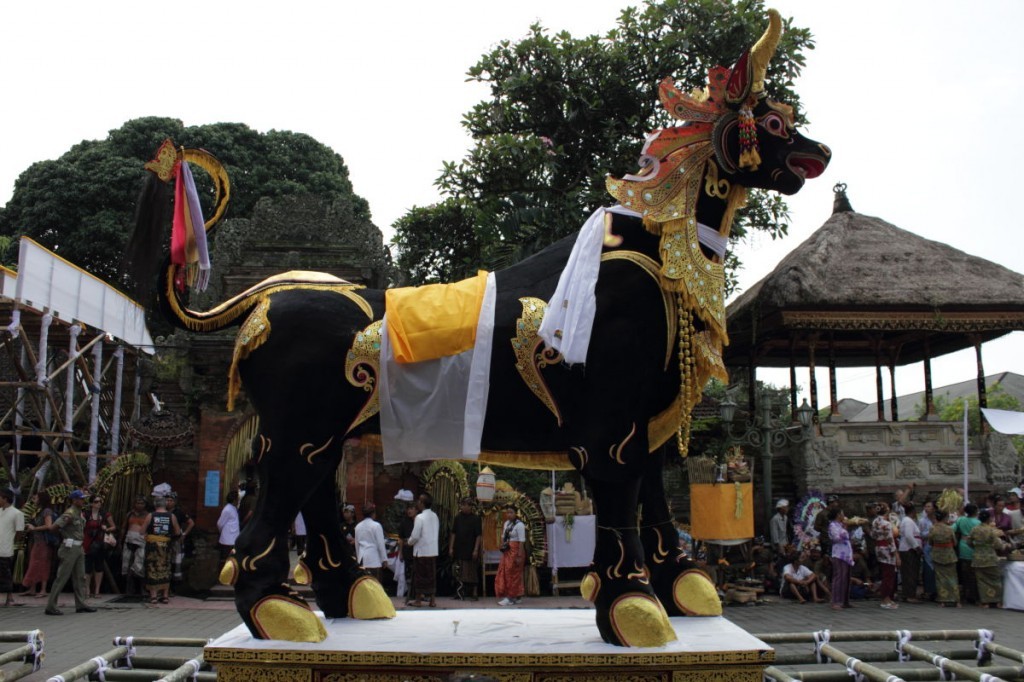
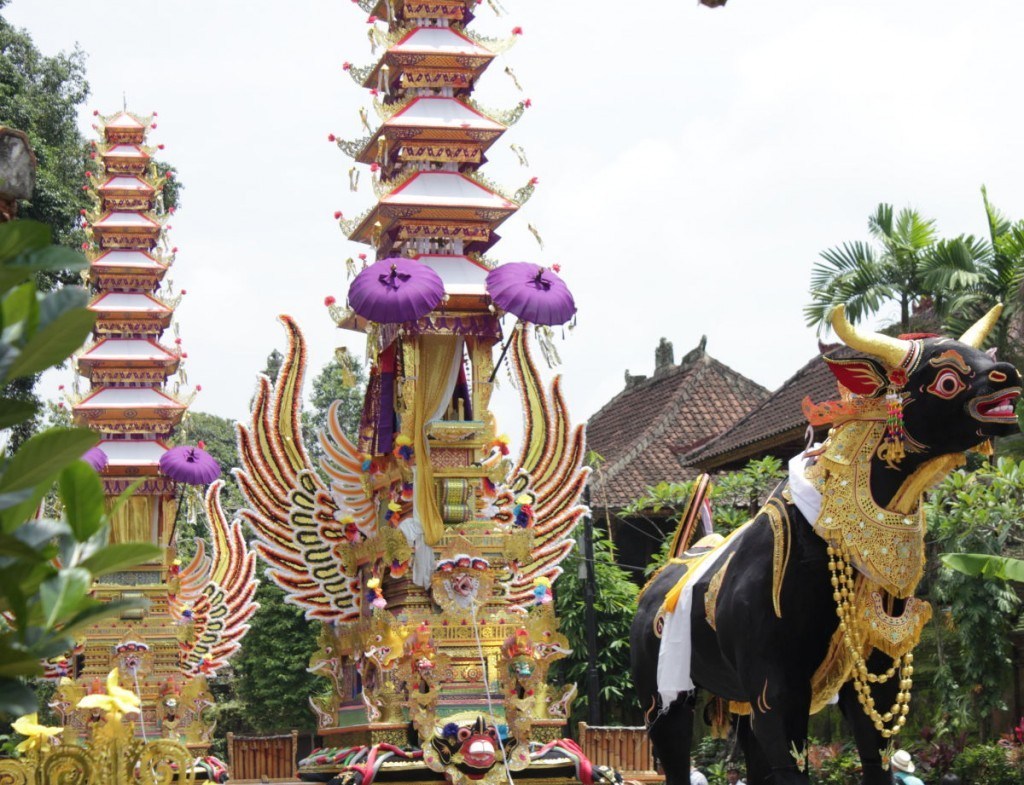
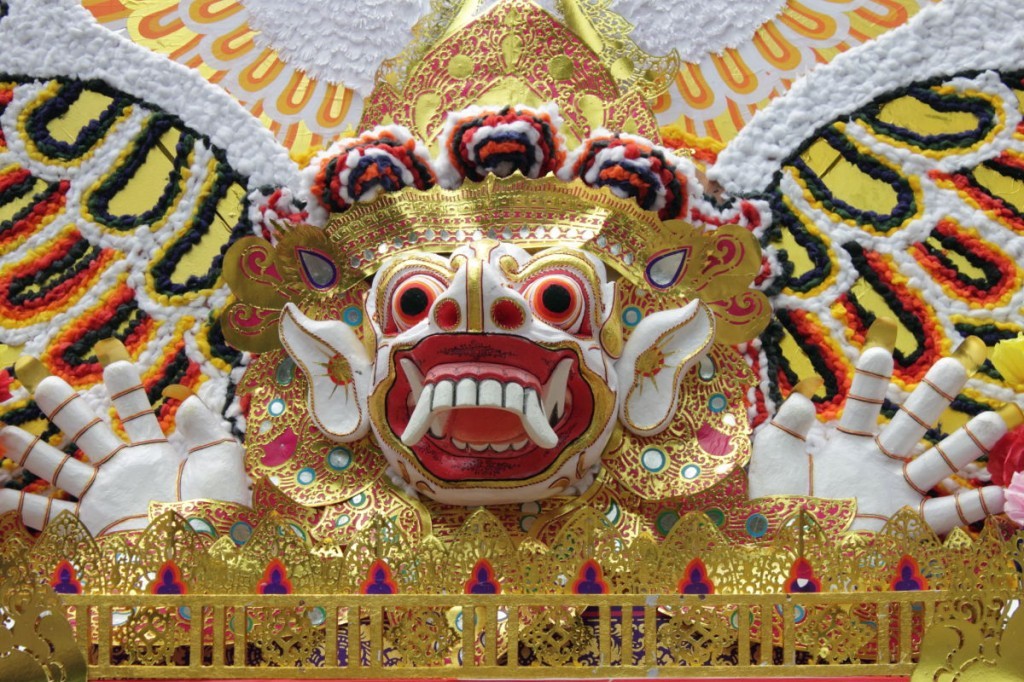
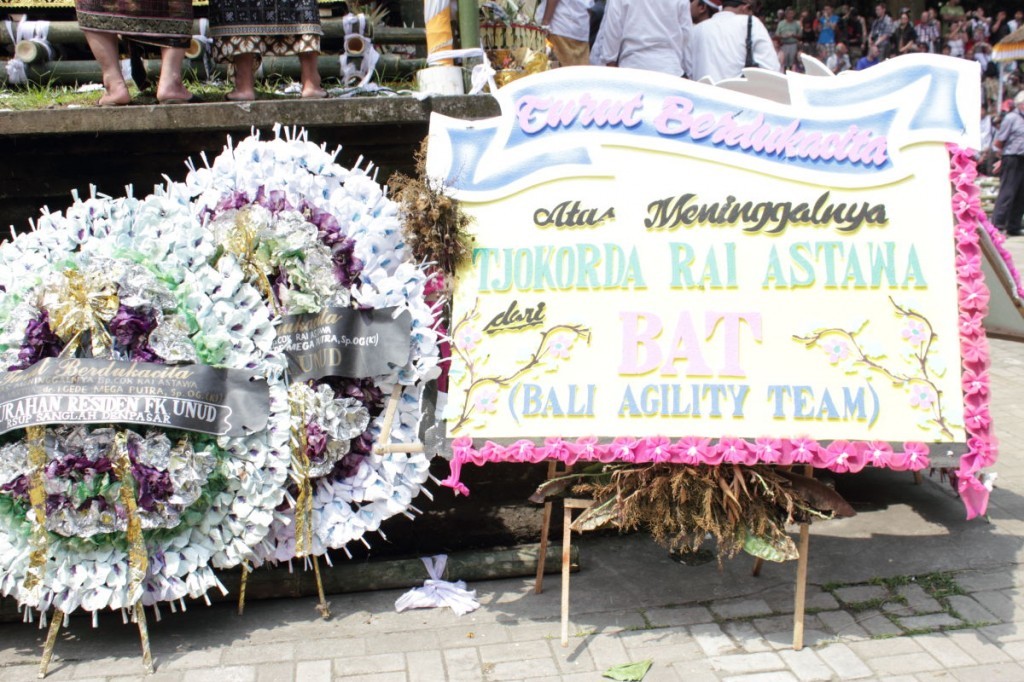
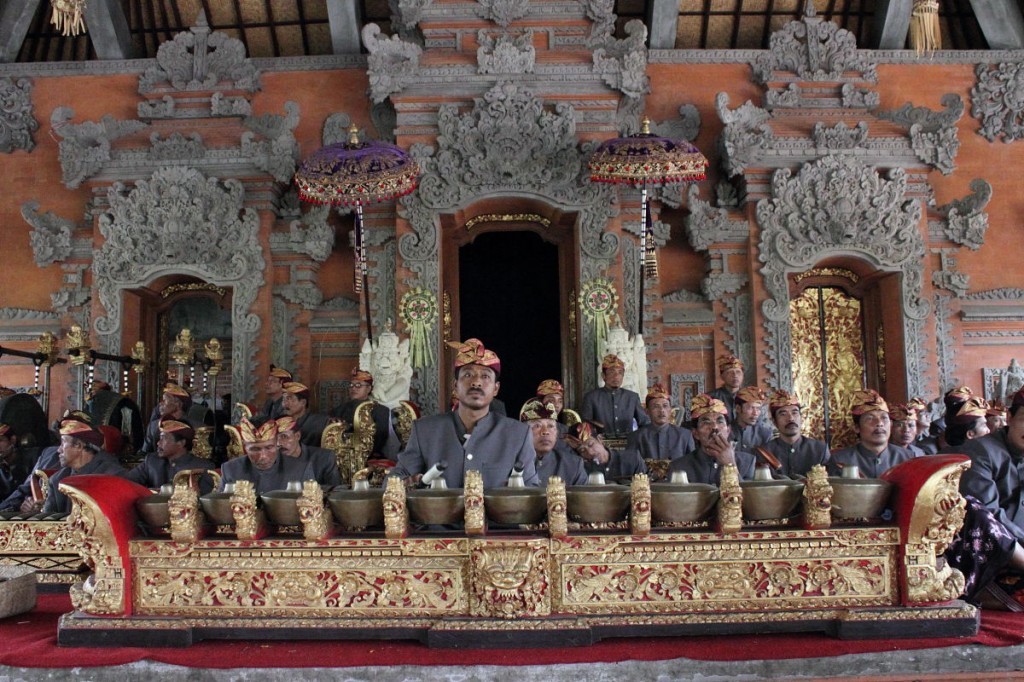
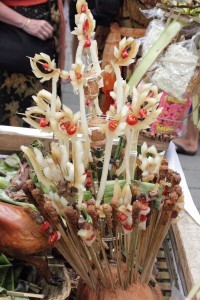
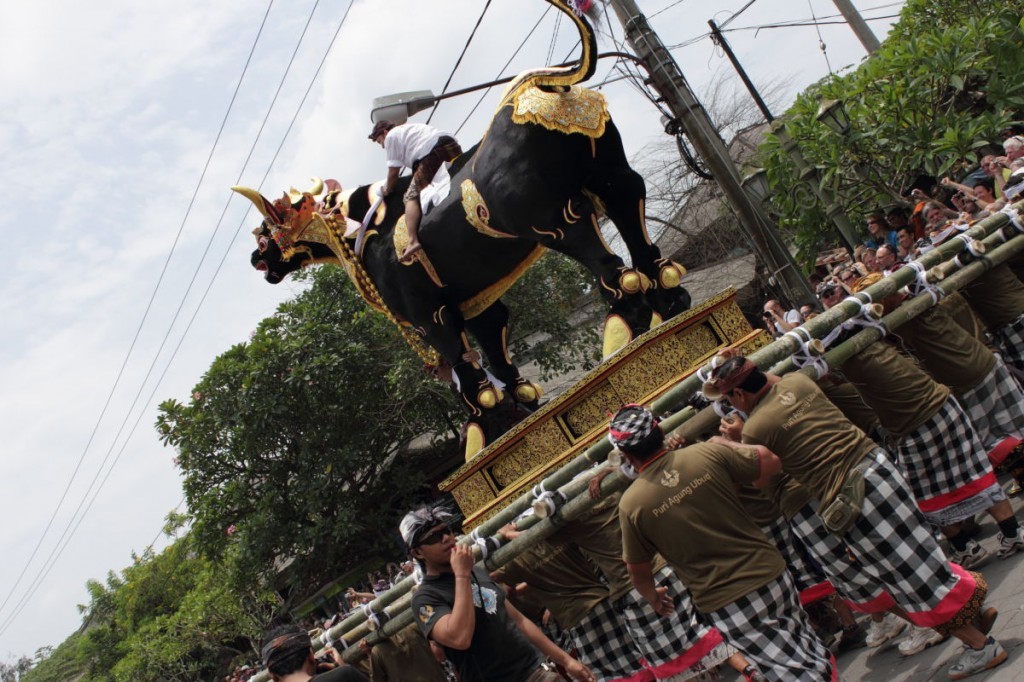
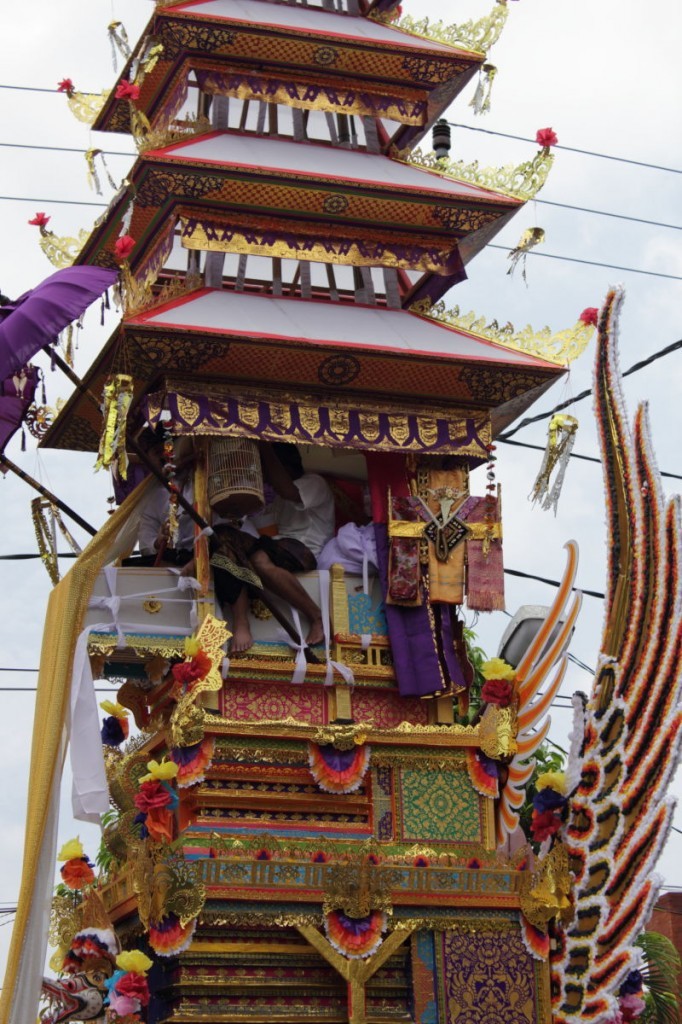
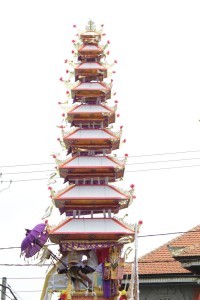
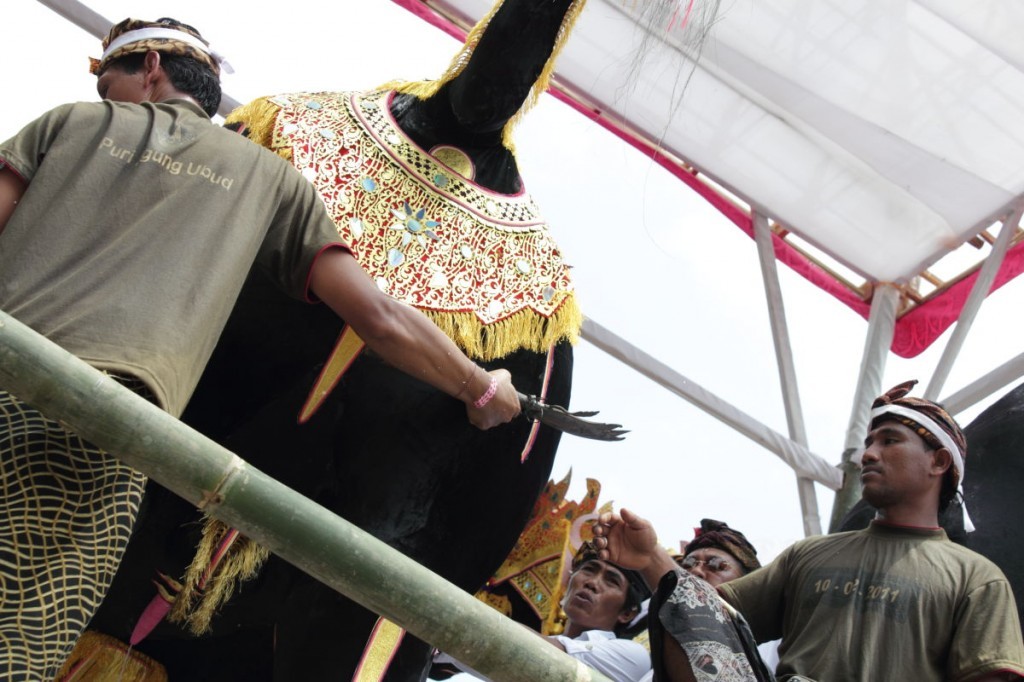
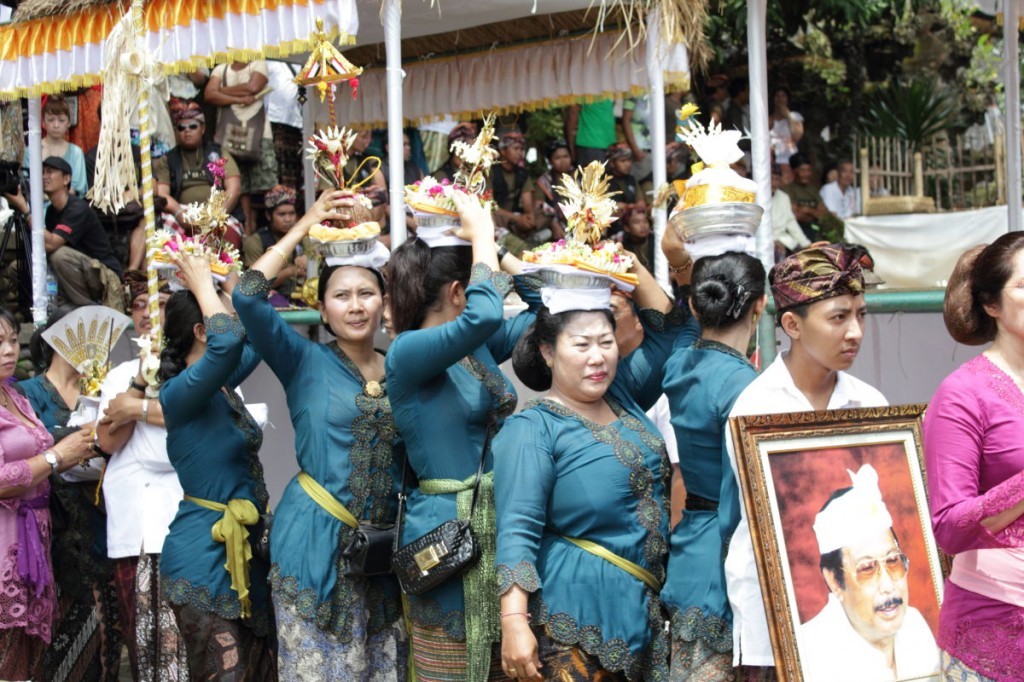
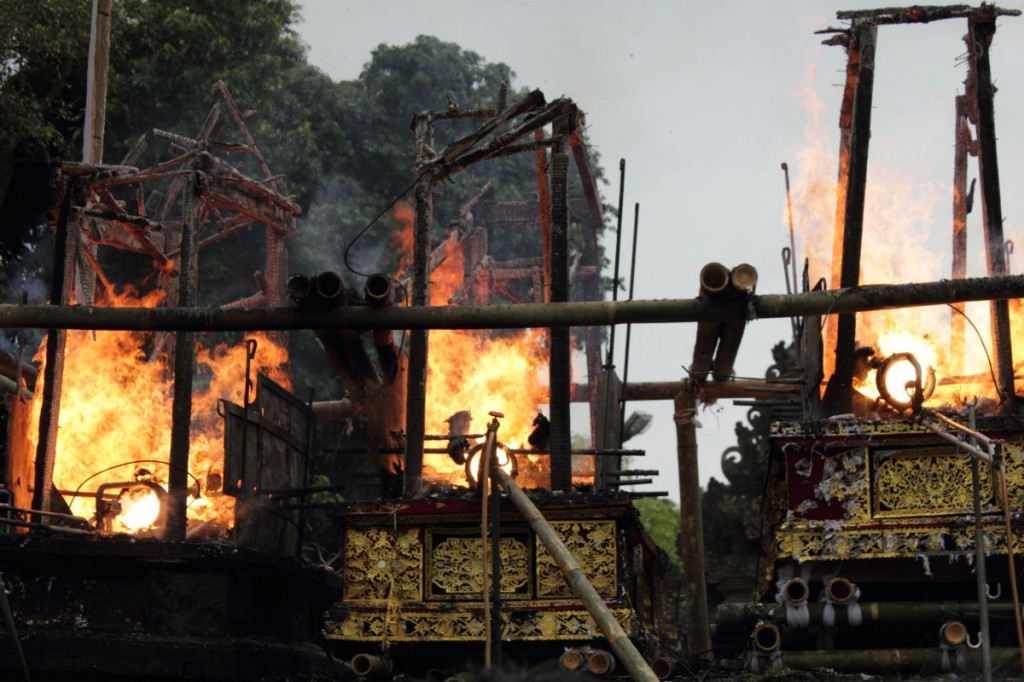
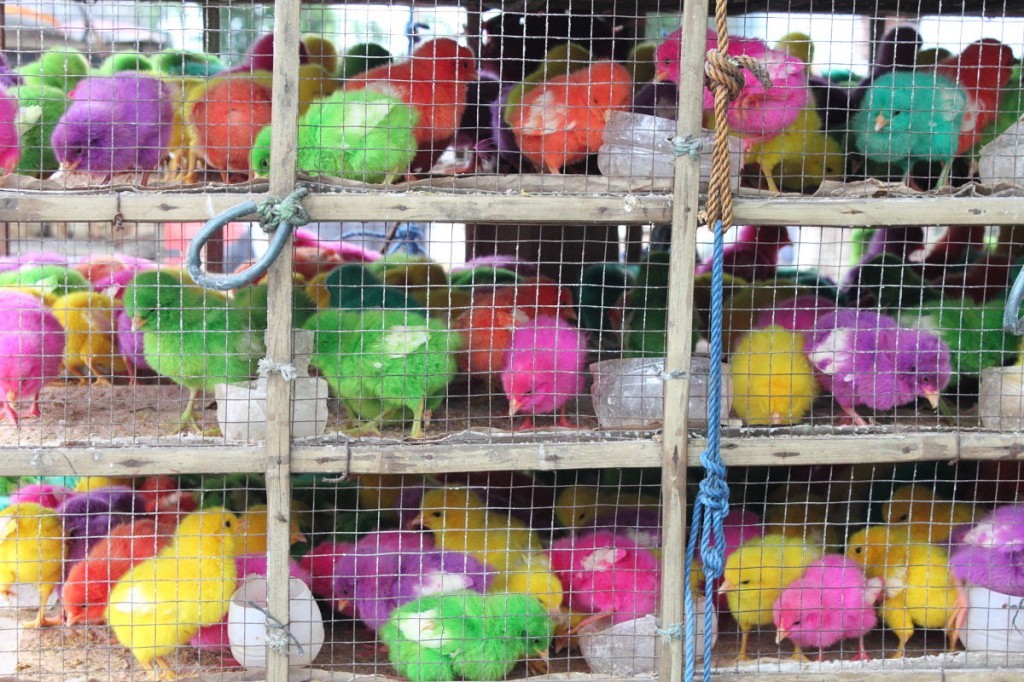
I think that rituals of different cultures are so fascinating. Your description of the cremation and all the ceremony around it is really well done. I had never heard anything about this before. Thanks for the post and excellent photos.
Thank you, Cathy. There’s an incredible diversity of ritual in all of Indonesia. So glad you enjoyed the piece…
What a great article! Love the pics and great descriptions. Such a great insight into Balinese culture. I love reading about these types of things.
Thank you! I love writing about them, too…
Great Post! I am sure that Z was fascinated by the whole thing and I agree wholeheartedly the best way to learn about a new culture is by celebrations of life and death.
As a pyromaniac, he likes cremations… Ahem!
bwa ha ha ~ as a fellow pyro I can find humor in that!
He wrote about it on his old blog: http://9yearold.wordpress.com/2010/11/02/kerosene-cremated/ Quite a funny piece, actually, if you have the time to take a look…
T, wonderful photos, and writing of course! I’ve never seen anything like it. We’re living close to a crematorium and fireworks (more like cannon blasts) are set off regularly. I jump out of my skin quite regularly.
Should I be afraid to ask about the coloured chicks? 😉
No need to be afraid. I don’t think they came to any harm. Though I am mystified as to what they were doing there…
I will find out from our Indonesian teacher at our class tomorrow whether they’re traditional at cremations, something to do with the day of the calendar, or what…
I couldn’t wait! I think they’re coloured just to make them look pretty for sale. It seems to be the done thing in quite a few different countries…btw, don’t Google ‘coloured chicks funerals’ 😉
You’re learning Indonesian?
Yes! I’m going to post about it. Z was learning with me but he’s opted to go to school those days instead, where they do teach Bahasa. He was doing pretty well, actually: it was an intensive class with adult learners (both speaking at least two languages already) who’d been learning for two months. But, honestly, I think he’s rather be learning the names of animals and fruits than different forms of transitivity in Indo verbs…
Wow, enthralling story and fascinating ceremony. What an awesome thing to witness!
We’ve been lucky — this is our second, in fact. The last one we went to, though, I only had a cheap film camera I’d bought at the market, and the pictures didn’t come out.
Hello, I am fortunate to be reltaed to one of the teachers at Green School. A bit more than 1 1/2 years ago, I was blessed to visit Bali, and the Green School Campus. Overwhelming, stunning, lifechanging and powerful. These feelings are still as strong, even though I am not there today. The students are composed of approximately 20% Balinese local students who attend on scholarship from Green School. As you pictured, the bamboo poles that comprise the structure can be carved with whatever you choose. I was pleased to know that the donation was very affordable. It was my pleasure to donate $100 to have a pole of my own . My cousin, who’s son teaches middle level students, have our poles carved right next to each other .very meaningful as we have known each other since childhood. This small price, to carve each donor pole, not ony leaves a lasting memory, but helps a Balinese child go to Green School. All of the children that attend Green School will make a difference in our world, look at the planet differently, with respect. Thank you for your article. It fills me with peaceful, joyous memories .Kathleen.
One of the things I love about your blog and travels is that even in touristy places like Bali you manage to find something unique to write about. Great storytelling, I almost felt like I was there.
Aw, thanks! It’s actually surprisingly easy to get off the beaten track here. Not so much at a big cremation in Ubud. But we took the back road between Bedugul and Batur, stopped at a small town, and my Bahasa held up enough to get the guy at the warung to find a coffee farmer for us, and he took us on a personal tour of his little farm… I’ve almost conquered my motorbike fears now, too, so hoping to get a bit further off it…
Do you double with Z?
Yep! He sits on the back, but tends to hold back bars rather than me, which is more comfortable. Our top speed, as agreed with his father, is 40kph, which always feels actually terribly rapid to me.
What a fantastic story! And what a way to go! Much grander than the processions we have for our former presidents here in the US!
As others have stated, always fascianting to see the differences in death rituals between societies. Though none I think are quite as odd (atleast to us) at the Tibetan “Sky Burial,” which I rejected a tour offered by my guest house to go see…
I can see why you turned down showing up at a burial in a tour bus. But a Tibetan sky burial is something I’d love to see…
Great post and a different perspective in Bali from what most people will get to experience during their visit. I always find it fascinating to see how different cultures and religions deal with death, with all the traditions and ceremonies that are built into life in their country. I’ve had friends who were in Tibet and invited to a sky burial and from their photos and prose, it is something I would be honoured to see in person. Safe travels, Theodora!
Thank you! Once you step outside the Kuta/Legian/Seminyak sprawl, it’s quite easy to see festivals as a part of daily life, including cremations: Kuta and that end are in some ways like a separate country…
Nice story
Thanks
I would have loved to witness something like this when I was in Bali. Great story!
We have Nyepi coming up this weekend, the Balinese New Year, which is going to be extraordinary. Not just the party beforehand, but the day of silence where all the electricity goes off…
Wow, what powerful photos. Ashamedly, I’ve spent very little time in Asia, and thus haven’t witnessed such a religious ceremony before. One day.
I’m surprised you’ve spent so little time in Asia. You must come. It’s addictive, though.
Awesome details. Bodies slipping from the bowels of burning bulls was decidedly NoT what I was expecting here but boy, am I glad I didn’t miss it! There is sooooo much I don’t know about that chunk of the world. Glad we have you to shave off selections like this for our reading pleasure.
Why, thank you… Less disturbing than what happens around the Ganges. But still eye-opening.
very interesting coverage. i’ve never seen or heard of this before. “formal sarongs” made me chuckle a bit.
It’s the default formal occasion dress here, bizarrely. With a sash, of course.
Wow, what an experience! Love those little colored chicks too…
Thank you! It is surreal how traditional ritual persists side by side with things like sophisticated Western restaurants in Ubud.
Before we had the poppet, we were lucky enough to witness a mass cremation in Ubud. It’s one of those experiences that sticks with you. Reading your account here really brings the event back to life for me. The decorated bamboo frames, women with sarongs stacked high, the heat & smoke, the pink felt. Great post!
It really does, doesn’t it, Mark? I find the rituals of funerals all over Indonesia quite fascinating.